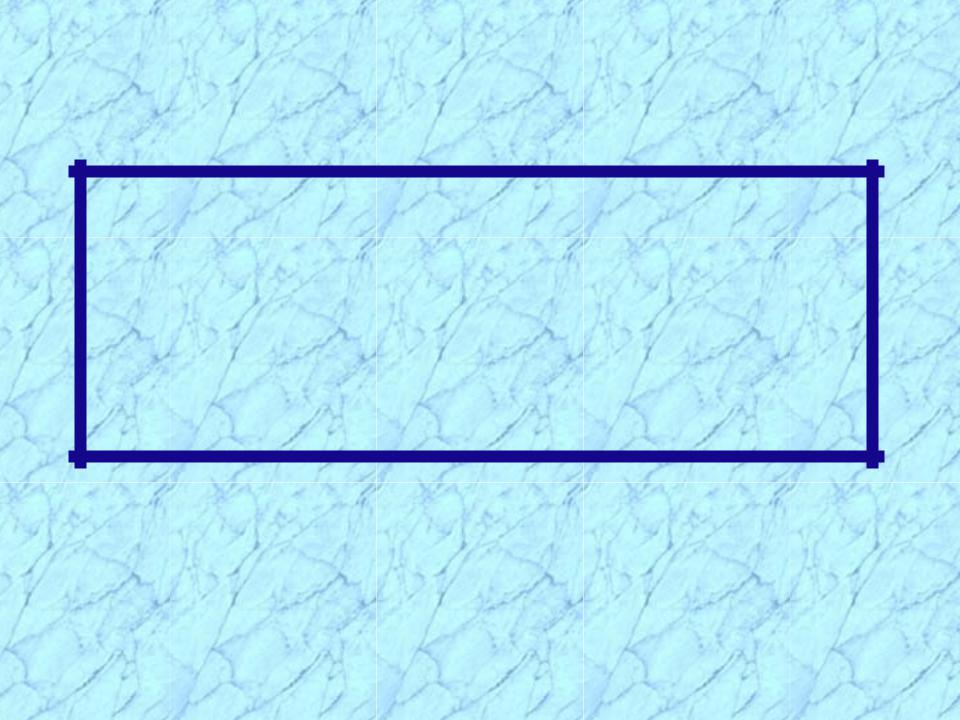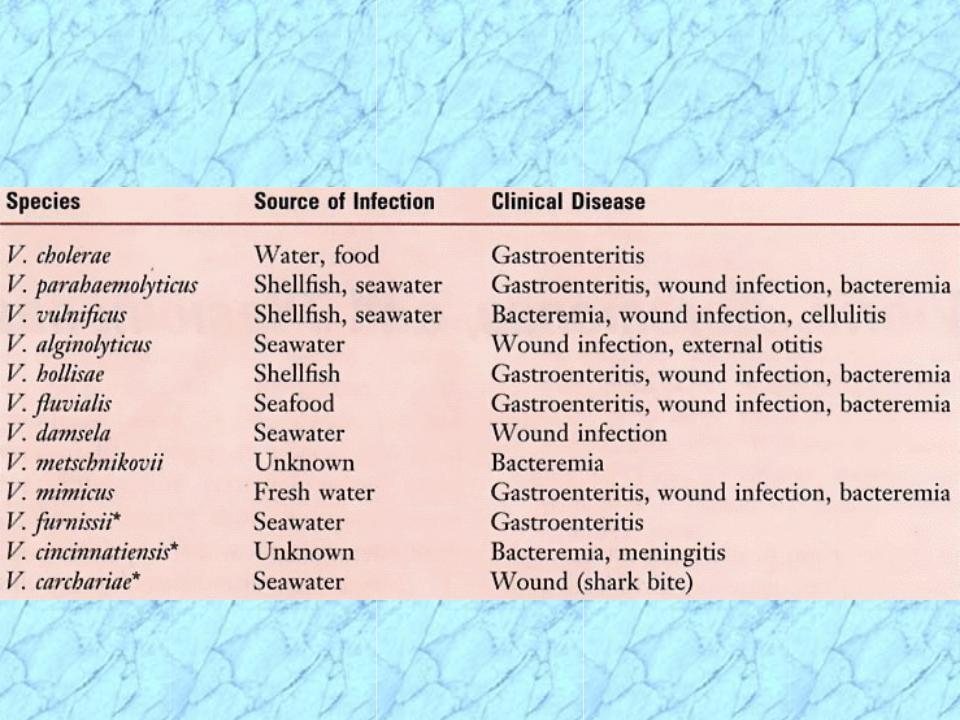
- •Vibrio, Aeromonas
- •General Characteristics of Vibrio,
- •Morphology & Physiology of Vibrio
- •Vibrio spp. (Family Vibrionaceae)
- •Epidemiology of Vibrio spp.
- •Taxonomy of Vibrio cholerae
- •Epidemiology of Vibrio cholerae
- •Recent Cholera Pandemics
- •Pathogenesis of V.cholerae
- •Pathogenesis of V.cholerae (cont.)
- •Treatment & Prevention of V. cholerae
- •Virulence Factors Associated with Vibrio cholerae O1 and O139
- •Two Broad Classes of Bacterial Exotoxins
- •Cholera Toxin (A2-5B)(Vibrio cholerae)
- •Mechanism 1
- •Mechanism of Action of Cholera Toxin
- •Heparin-binding epidermal growth factor on heart & nerve surfaces
- •Summary of Vibrio
- •Summary of Vibrio vulnificus Infections
- •Virulence Factors Associated with Non-cholerae Vibrios
- •Laboratory Identification of Vibrios
- •Characteristics and Epidemiology of
- •Clinical Syndromes of Aeromonas
- •Afimbriated
- •Fimbriated
- •Characteristics of Plesiomonas
- •Characteristics of Aeromonas and
- •REVIEW
- •Vibrio spp. (Family Vibrionaceae)
- •Epidemiology of Vibrio spp.
- •Taxonomy of Vibrio cholerae
- •Epidemiology of Vibrio cholerae
- •Summary of Vibrio cholerae Infections
- •Summary of Vibrio cholerae Infections (cont.)
- •Pathogenesis of V.cholerae (cont.)
- •Virulence Factors Associated with Vibrio cholerae O1 and O139
- •Mechanism of Action of Cholera Toxin
- •Summary of Vibrio
- •Summary of Vibrio vulnificus Infections
- •Virulence Factors Associated with Non-cholerae Vibrios
- •Characteristics and Epidemiology of
- •Clinical Syndromes of Aeromonas
- •Characteristics of Plesiomonas
- •Characteristics of Aeromonas and


Vibrio, Aeromonas
& Plesiomonas

General Characteristics of Vibrio,
Aeromonas and Plesiomonas
Similarities to EnterobacteriaceaeGram-negative
Facultative anaerobesFermentative bacilli
Differences from Enterobacteriaceae
Polar flagellaOxidase positive
Formerly classified together as VibrionaceaePrimarily found in water sources
Cause gastrointestinal disease
Shown not closely related by molecular methods

Morphology & Physiology of Vibrio
Comma-shaped (vibrioid) bacilli
V. cholerae, V. parahaemolyticus, V. vulnificus are most significant human pathogens
Broad temperature & pH range for growth on media
18-37 C
pH 7.0 - 9.0 (useful for enrichment)
Grow on variety of simple media including:
MacConkey’s agar
TCBS (Thiosulfate Citrate Bile salts Sucrose) agar
V. cholerae grow without salt
Most other vibrios are halophilic

Vibrio spp. (Family Vibrionaceae)
Associated with Human Disease

Epidemiology of Vibrio spp.
Vibrio spp. (including V. cholerae) grow in estuarine and marine environments worldwide
All Vibrio spp. can survive and replicate in contaminated waters with increased salinity and at temperatures of 10-30oC
Pathogenic Vibrio spp. appear to form symbiotic (?) associations with chitinous shellfish which serve as an important and only recently recognized reservoir
Asymptomatically infected humans also serve as an important reservoir in regions where cholera is endemic

Taxonomy of Vibrio cholerae
>200 serogroups based on somatic O-antigen
O1 and O139 serogroups are responsible for classic epidemic cholera
O1 serogroup subdivided into
Two biotypes: El Tor and classical (or cholerae)
Three serotypes: ogawa, inaba, hikojima
Some O1 strains do not produce cholera enterotoxin (atypical or nontoxigenic O1 V. cholerae)
Other strains are identical to O1 strains but do not agglutinate in O1 antiserum (non-cholera (NCV) or non-agglutinating(NAG) vibrios) (non-O1 V.cholerae)
Several phage types

Epidemiology of Vibrio cholerae
Cholera recognized for more than two millennia with sporadic disease and epidemics
Endemic in regions of Southern and Southeastern Asia; origin of pandemic cholera outbreaks
Generally in communities with poor sanitation
Seven pandemics (possible beginning of 8th) since 1817 attributable to increased world travel
Cholera spread by contaminated water and food
Human carriers and environmental reservoirs

Recent Cholera Pandemics
7th pandemic:
V. cholerae O1 biotype El Tor
Began in Asia in 1961
Spread to other continents in 1970s and 1980s
Spread to Peru in 1991 and then to most of South & Central America and to U.S. & Canada
By 1995 in the Americas, >106 cases; 104 dead
8th pandemic (??)
V. cholerae O139 Bengal is first non-O1 strain capable of causing epidemic cholera
Began in India in 1992 and spread to Asia, Europe and U.S.
Disease in humans previously infected with O1 strain, thus no cross-protective immunity

Pathogenesis of V.cholerae
Incubation period: 2-3 days
High infectious dose: >108 CFU
103 -105 CFU with achlorhydria or hypochlorhydria
(lack of or reduced stomach acid)
Abrupt onset of vomiting and life-threatening watery diarrhea (15-20 liters/day)
As more fluid is lost, feces-streaked stool changes to rice-water stools:
Colorless
Odorless
No protein
Speckled with mucus

Pathogenesis of V.cholerae (cont.)
Cholera toxin leads to profuse loss of fluids and electrolytes (sodium, potassium, bicarbonate)
Hypokalemia (low levels of K in blood)
Cardiac arrhythmia and renal failure
Cholera toxin blocks uptake of sodium & chloride from lumen of small intestine
Death attributable to:
Hypovolemic shock (due to abnormally low volume of circulating fluid (plasma) in the body)
Metabolic acidosis (pH shifts toward acid side due to loss of bicarbonate buffering capacity)
